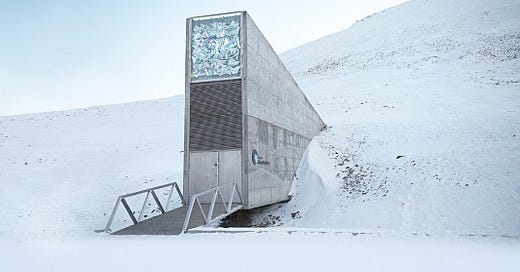The Svalbard seed vault – a synoptic link between food and climate change
In the Arctic wilderness, on the Norwegian island of Spitzbergen, lies a vault built to help withstand potential damaging impacts of climate change. Opened in 2008, the Svalbard seed vault is a ‘backup’ for gene banks around the world. The vault sits 120 metres into rock, helping the rooms there to remain naturally below freezing, and can store 4.5 million varieties of seeds of mostly food crops.
Recently it received one of its biggest deposits, 30,000 samples of crop seeds from 21 countries, in its history. This contribution could prove valuable to mankind as climate change affects the crops that can be grown in certain places. The new deposit contained pearl millet and groundnut variants from India, corn and beans from Bolivia, and more than 7,000 rice samples from the Philippines. Seeds also arrived from conflict-ridden Palestine. Chad’s consignment included sesame and sorghum - a particularly significant contribution considering these crop varieties are adapted to the country’s dry climate, and therefore crucial for developing crops that can withstand rising temperatures and erratic rains. Some of the seeds are called ‘opportunity crops,’ which can thrive in challenging conditions but are currently rarely part of peoples’ diets, including okra, millets and pigeon pea.
The influx of seeds underscores global efforts to preserve crop diversity as conflict also disrupts food security. Just three crops - rice, wheat and corn - provide roughly half of the world’s calories. Gene banks - there are more than 1,000 globally - are now becoming more risk sensitive.
The Svalbard vault has already seen one early withdrawal. It had safely stored some crucial varieties of wheat and pulses from the fertile region of Mesopotamia (present-day Iraq and Syria). After civil war prevented the gene bank in Syria from being maintained, Svalbard released some samples so that they could now be stored in Lebanon and Morocco.
The Svalbard Seed Vault
(Not dissimilar to the entrance to Tutankhamun’s tomb!)
Source: Tours Svalbard
Quiz time (2). Population
1. In which year did the world’s population exceed 8 billion people?
2. How many years did it take the world’s population to double from 3.5 billion to
7 billion?
3. Which country has the world’s third largest population?
4. Which country has the fastest population growth rate?
5. India’s population in 2011 was estimated to be 1.21 billion. What is its population expected to be by 2050?
6. Roughly how many babies are born worldwide each day?
7. Japan’s population in 2022 was 125 million, but it is declining at a rate of – 0.7% per year. What is Japan’s total population expected to be in 2050?
8. Which continent has the highest percentage of the world’s population?
9. What percentage of the world’s population lives in urban areas?
10. Monaco and Singapore are the most densely populated countries in the world. Which is the least densely populated country?
Answers
1. The answer is 2022. The UN declared 15th November 2022 the ‘Day of 8 billion’. The UN declared 31 October 2011 the ‘Day of 7 billion’. The ‘Day of 6 billion’ was 12 October 1999.
2. The answer is 43 years. The population in 1968 was 3.5 billion and was estimated to have become 7 billion in 2011. To get from 1 billion to 2 billion took 123 years, from 1804 to 1927.
3. The answer is USA. In 2023 the US population was 335 million. (Indonesia 279 million, Pakistan 240 million, Brazil 204 million).
4. The answer is Niger. In 2023 it was estimated to be growing at 3.7% per year giving a population doubling time of 20 years.
5. The answer is 1.67 billion. By 2050 India is expected to ‘add’ a population of about 450 million (a gain larger than ‘a USA’) making it the largest country by population in 2050. China’s population is expected to peak by 2025.
6. The answer is 385,000. [By comparison, in 2024, Apple sold 263,000 iPhones per day]
7. The answer is 102 million. The country will have lost ‘a Taiwan’.
8. The answer is Asia, which contained 59% of the world’s population in 2023 or 4.79 billion people.
9. The answer is 57% although it depends on how exactly ‘urban’ is defined. 23rd May 2007 was ‘urban day’ when the world became more urban than rural.
10. The answer is Mongolia. In 2023 its population density was 2 people per km2 compared to 26,000 people per km2 in Monaco.




